A/C SYSTEM GENERAL SERVICING
1988 Jeep Cherokee
1988 AIR CONDITIONING & HEAT
A/C General Servicing
Diagnostic Procedures
Eagle & Jeep
* PLEASE READ THIS FIRST *
CAUTION: When discharging air conditioning system, use only approved
refrigerant recovery/recycling equipment. Make every attempt
to avoid discharging refrigerant into the atmosphere.
INTRODUCTION
This article is to be used for general service and diagnosis.
For specific repair or replacement procedures, use the appropriate
repair article in this section.
R-12 REFRIGERANT - SAFETY PRECAUTIONS
1) Always work in a well-ventilated, clean area. Refrigerant
(R-12) is heavier than oxygen, and will displace oxygen in a confined
area. Always wear eye protection when working around air conditioning
systems and R-12. The system’s high pressure can cause severe injury
to eyes and skin if a hose were to burst. R-12 evaporates quickly
when exposed to atmosphere, freezing anything it contacts.
2) Use care when handling refrigerant containers. Do not
drop or strike containers. Do not expose refrigerant containers to
excessive heat. Containers must never be heated more than 125
Never expose R-12 directly to open flame.
CAUTION: When R-12 is exposed to an open flame, drawn into a running
engine, or detected with a Halide (propane) leak tester,
poisonous phosgene gas is formed. Keep work areas
ventilated and keep vehicles with running engines away.
USING INDIVIDUAL R-12 CANS
Disposable refrigerant cans (referred to as one pound cans)
have a flat type seal or a screw type seal, and the proper can tap
must be used for each type. Be sure sealing gasket on can tap is in
good condition. A proper safety can tap will prevent refrigerant from
flowing back into open can, as the tap has a one-way flow control.
NOTE: Recent findings by the EPA indicate that R-11, R-12 and
R-113 are harmful to the Earths’ protective Ozone layer.
Make every attempt possible, to avoid discharging R-11, R-12
or R-113 into the atmosphere.
USING MULTI-CAN DISPENSING VALVES
A multi-can dispensing valve allows the attachment of
several cans of refrigerant, and is a good substitute when a bulk
container is not available. Cans are installed onto each leg of the
multi-can dispensing valve in the same manner as the individual cans,
and each leg has its own can tap.
CAN TAP INSTALLATION
FLAT TYPE SEAL CANS
On cam-lock or one-piece can taps, first turn the handle out
to the fully open position. Securely engage the locking lugs over the
flange of the can, and lock them in place by turning the cam lock or
locking nut. Screw the tap assembly into the adapter so the sealing
gasket is fully seated against the can top. Turn the tap inward to
pierce the can and close the tap. DO NOT open the tap until ready to
purge the service hose or dispense refrigerant into the system.
On 2-piece can taps, be certain the tap handle is turned
fully in, so it is closed. Check that the locking base is turned to
its outer limit. Securely engage the locking lugs over the can
flange. Turn the entire tap assembly (without disturbing the closed
setting) down into the locking base to pierce the can. Do not open
the tap until ready to dispense into system.
SCREW TYPE SEAL CANS
Ensure can tap is fully closed. Screw refrigerant can into
can tap fitting until tight. This will pierce the can. Connect tap to
center hose on manifold gauge set. DO NOT open tap until ready to
dispense R-12 into system.
WARNING: DO NOT open high side hand valve while air conditioning
system is in operation. This high pressure could rupture
can or possibly burst fitting at safety can valve,
resulting in damage and physical injury.
COMPRESSOR OIL CHECK
GENERAL PROCEDURES
Some models have compressor-mounted service valves that allow
oil checking by isolating the compressor. On all others, system must
be discharged, using approved refrigerant recovery/recycling
equipment, and compressor may need to be removed to check oil. After
oil level is checked and adjusted, A/C system must be evacuated and
recharged.
ISOLATING COMPRESSOR
1) Connect manifold gauge set to service valves on the
compressor. Close both gauge valves. Open both service valves to
themid-position.
2) Start engine and operate air conditioning. Turn suction
service valve slowly clockwise toward front-seated position. When
suction pressure is reduced to zero or less, stop engine and quickly
close suction service valve (front-seated).
3) Front-seat the discharge valve. Loosen oil check plug
slowly to release any internal pressure. Service valves can now be
removed from compressor and compressor removed from vehicle (if
necessary). Purge compressor after servicing.
PURGING COMPRESSOR
1) Remove gauge set and place caps on service valve ports.
Back-seat the suction service valve to allow refrigerant to enter
compressor.
2) Loosen discharge port valve slightly. Loosen valve port
cap to allow refrigerant to force out air from compressor. Back-seat
the discharge valve and tighten the port cap. Compressor is ready for
service.
REFRIGERATION OIL
Only new, pure, moisture-free refrigeration oil should be
used in the air conditioning system. This oil is highly refined and
dehydrated (moisture content less than 10 parts per million).
Refrigeration oil container must be kept tightly closed at
all times when not in use, or moisture will be absorbed from the air
and introduced into the refrigeration system.
NIPPONDENSO 10-CYLINDER
SHAFT SEAL
NOTE: Check compressor refrigerant oil level when replacing seals.
See COMPRESSOR REFRIGERANT OIL CHECKING article in this
section.
Removal
1) Hold clutch hub stationary and remove center nut. Screw
remover into center of hub. Turn center bolt to remove pressure plate.
2) Remove shims from shaft. Remove snap ring from inside of
pulley. Tap pulley off of shaft with plastic mallet. Be careful not
to distort pulley while removing.
3) Disconnect clutch coil wires from compressor housing.
Remove snap ring inside coil and lift coil off compressor. Pry dust
seal out from around compressor shaft (if equipped).
4) Place shaft key remover on shaft and turn to remove key.
Remove drain plug (if equipped). Remove bolts holding service valves
to body of compressor and remove valves. Discard "O" rings. Drain oil
out of compressor.
5) Remove 6 through bolts from front head of compressor and
discard washers. Tap head loose from compressor, being careful not to
scratch sealing surfaces. Remove snap ring (if equipped) from front
housing. Press seal plate out. Remove seal from shaft. See Fig. 1.
Installation
1) Lubricate shaft seal with clean refrigerant oil. Place on
compressor shaft. Lubricate seal plate (and "O" ring, if equipped) and
install in front housing. Install snap ring (if equipped).
2) Place front housing on compressor body. Using new
washers, install through bolts. Tighten bolts evenly and alternately
to 18 ft. lbs. (24 N.m). Install shaft key with installer and plastic
mallet. Insert dust seal into front of compressor.
3) Install drain plug using new gasket. Add correct amount
of refrigerant oil to compressor. If service valves were removed,
coat new "O" rings with refrigerant oil and install service valves.
4) Place clutch coil on compressor and install snap ring.
Install shims on shaft to adjust clearance between pressure plate and
rotor to .016-.028" (.41-.71 mm). Tighten shaft nut to 12 ft. lbs. (16
N.m). See REFRIGERANT OIL & R-12 SPECIFICATIONS table for system
capacities.
SANKYO/SANDEN 5-CYLINDER COMPRESSOR SERVICING
NOTE: During the past year, Sankyo International (USA), Inc. has
changed its name to Sanden International (USA), Inc.
Information pertaining to Sanden compressors in this article,
will be found in earlier articles under Sankyo compressors.
AMERICAN MOTORS & JEEP WITH 5-CYLINDER COMPRESSOR
Compressor Overhaul
1) After the compressor and system have been run, stop the
engine. Slowly discharge system using approved refrigerant
recovery/recycling equipment. Clean and cool dipstick with R-12.
2) Loosen the compressor mounting bolts, remove the drive
belt, and move the compressor to a bench for easiest and most accurate
measurement. Position the compressor so that the oil fill plug is at
top dead center.
3) Thoroughly clean the oil fill plug and the area around it.
Loosen the fill plug slowly to allow trapped refrigerant pressure to
escape through the loosened threads.
4) The front plate hub has a lobe, which is indexed (notched)
180
index notch is 110
position by looking through the oil fill hole and noting that the ball
end of the top piston rod lines up with the fill hole.
5) Looking at the front end of the compressor, insert the
dipstick diagonally from upper left to lower left until the dipstick
stop contacts the filler hole surface. Remove dipstick and note oil
level. Oil level should be between the 4th and 6th increment on the
dipstick (3-4 ounces). Add oil as necessary.
Compressor Replacement
If system was opened by a leak or so quickly that oil was
lost, install new compressor with all the oil it contains. If system
was opened slowly and oil was not lost, drain oil from new compressor
and measure. Reinstall 6 ounces of oil back into new compressor prior
to installation.
Component Replacement
If a hose, receiver-drier, condenser, expansion valve or
evaporator core requires replacement, add 1 ounce of new oil for each
new component installed.
Compressor Oil Check
1) Discharge system, using approved refrigerant
recovery/recycling equipment, or isolate compressor. Remove oil filler
plug. Look through oil filler plug hole and rotate clutch front plate
to position piston connecting rod in center of oil filler plug hole.
2) Insert dipstick (J-29642-12) through oil filler plug hole
to the right of piston connecting rod until dipstick stop contacts the
compressor housing.
3) Remove dipstick and count number of increments covered
with oil. If compressor is properly filled, oil will cover 4-6
increments on the dipstick. Adjust oil level as necessary.
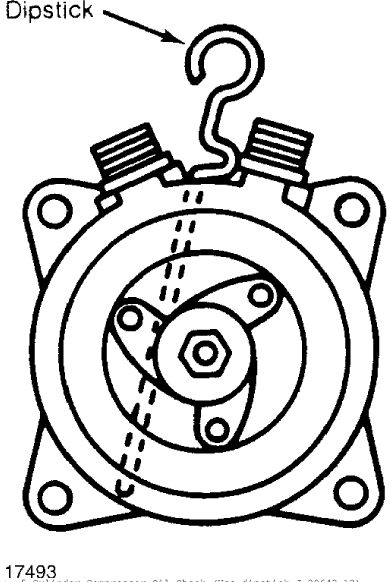
Fig. 1: 5-Cylinder Compressor Oil Check (Use dipstick J-29642-12)
YORK 2-CYLINDER COMPRESSOR SERVICING
from TDC of the cam rotor. Rotate the hub plate lobe until the�� from bottom center. See Fig. 1. Check thisJEEP WITH 2-CYLINDER COMPRESSOR
Isolating Compressor
1) Connect manifold gauge set to service valves on
compressor. Close both gauge valves. Open both service valves to the
mid-position.
2) Start engine and operate air conditioning. Turn suction
service valve slowly clockwise toward front-seated position. When
suction pressure is reduced to zero or less, stop engine and quickly
close suction service valve (front-seated).
3) Front-seat the discharge valve. Loosen oil check plug
slowly to release any internal pressure. Service valves can now be
removed from compressor and compressor removed from vehicle (if
necessary). Purge compressor after servicing.
Purging Compressor
1) Remove gauge set and place caps on service valve ports.
Back-seat the suction service valve to allow refrigerant to enter
compressor.
2) Loosen discharge port valve slightly. Loosen valve port
cap to allow refrigerant to force out air from compressor. Back-seat
the discharge valve and tighten the port cap. Compressor is ready for
service.
Compressor Oil Check
1) Operate system for 10 minutes, then stop and isolate
compressor. Loosen filler plug slowly to release any pressure in
crankcase.
2) Use dipstick to check oil level. See Fig. 2. Add oil as
necessary. Install plug with new "O" ring. Purge compressor of air.
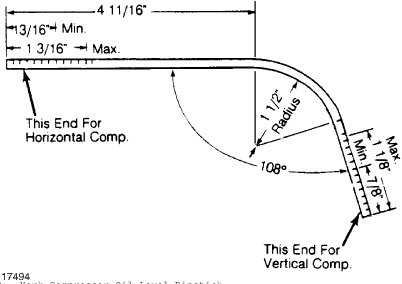
Fig. 2: York Compressor Oil Level Dipstick
Check oil with shaft keyway facing head.
SYSTEM SERVICING CAUTIONS
BEFORE OPENING THE SYSTEM
Before disconnecting any lines or fittings, the system must
be completely discharged using approved refrigerant recovery/recycling
equipment.
DISCONNECTING LINES & FITTINGS
1) After system is discharged, carefully clean entire area
around coupling nut to prevent dirt entering system. Always use two
wrenches to avoid twisting or distorting lines and fittings (hold
fitting with one wrench while loosening coupling nut with second
wrench).
2) Ford spring-coupling fittings require a special coupling
tool (Motorcraft YT-1056) to open or close. See procedure under
CONNECTING LINES & FITTINGS.
3) Cap or plug all LINES and FITTINGS immediately to prevent
entry of air and moisture into the system. Do not remove these caps
until connections are being made.
COMPONENT REPLACEMENT
When components are replaced, system oil level must be
adjusted. Add refrigeration oil to replacement component. See
Compressor Oil Check article, as well as, Component Oil Replacement
Quantities" chart under A/C SYSTEM SERVICE SPECIFICATIONS in this
article.
CONNECTING LINES & FITTINGS
All Except Ford Spring-Coupling Fitting
1) A new "O" ring should be used in all instances when
connecting lines and fittings (dip "O" ring in clean refrigeration oil
and make certain it is not twisted during installation). Always use
two wrenches to avoid twisting or distorting lines and fittings.
Tighten coupling nuts securely.
2) Ford spring-coupling fittings require a special coupling
tool (Motorcraft YT-1056) to open or close. Use the following
procedure to connect or disconnect the spring-coupling fitting.
Ford Spring-Coupling Fitting
1) Discharge system using approved refrigerant
recovery/recycling equipment. Place proper end of tool over
refrigerant line. Tool fits both 3/8" and 1/2" fittings. Push tool
into fitting cage to release spring inside. Pull lines apart and
remove tool.
2) Before connecting, check internal spring for damage. If
Necessary, pry spring out and replace it. Clean fittings and install
new "O" rings.
CAUTION: Use ONLY "O" rings designed for these Ford fittings
(Motorcraft YF-982). Normal refrigerant "O" rings will NOT
seal.
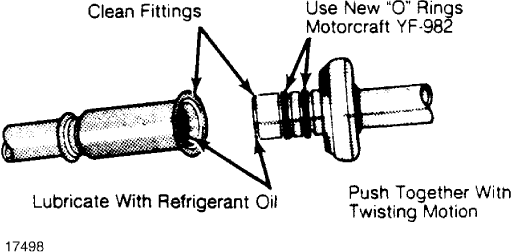
Fig. 3: Assembling Ford Spring-Coupling Fitting
3) Lubricate both sides of fitting with clean refrigeration
oil. Assemble the fitting by pushing together with a slight twisting
motion. Check to make sure spring is over flared end of female
fitting.
PLACING SYSTEM IN OPERATION
After component replacement and/or system servicing has been
completed and all connections have been made, proceed as follows:
1) Evacuate the system using vacuum pump.
2) Charge the system with R-12. See REFRIGERANT CAPACITY in
the A/C SYSTEM SERVICE SPECIFICATIONS in this article.
3) Leak test the system, with particular attention to all new
connections and components.
4) Make a performance test of the system. Never assume that a
recharging has automatically corrected a problem.
DIAGNOSTIC PROCEDURES
Diagnosis is an important first step in A/C system servicing.
To save time and effort, systems should be carefully checked to
identify the causes of poor performance. By using the following
diagnostic charts, defective components or system damage can be
quickly located. To identify problems that are specific to one system,
refer to the repair sections of this article. The charts in this
article apply to all systems.
PREPARATION FOR TESTING
1) Attach Low and High side gauges.
2) Start engine and allow it to warm up.
3) Set system to COOL and blower to HIGH.
4) Open car doors and hood.
5) Run at fast idle for 2-3 minutes.
ALTITUDE PRESSURE VARIATIONS
ALTITUDE PRESSURE VARIATIONS
Altitude (Ft. Absolute Pressure Gauge Altitude
Above Sea Level) of Atmosphere(psi) Correction(1) (psi)
0 ...................... 14.7 ........................ 0
1000 ................... 14.2 ..................... -0.5
2000 ................... 13.7 ..................... -1.0
3000 ................... 13.2 ..................... -1.5
4000 ................... 12.7 ..................... -2.0
5000 ................... 12.2 ..................... -2.5
6000 ................... 11.7 ..................... -3.0
7000 ................... 11.3 ..................... -3.4
8000 ................... 10.9 ..................... -3.8
9000 ................... 10.5 ..................... -4.2
10,000 ................. 10.1 ..................... -4.6
(1) - Subtract correction shown from gauge readings.
ALTITUDE VACUUM VARIATIONS
Altitude (Ft. Complete Vacuum Gauge Altitude
Above Sea Level) (In. Hg) Correction (In. Hg)
0 ...................... 29.92 ....................... 0
1000 ................... 28.92 .................... +1.0
2000 ................... 27.82 .................... +2.1
3000 ................... 26.82 .................... +3.1
4000 ................... 25.82 .................... +4.1
5000 ................... 24.92 .................... +5.0
6000 ................... 23.92 .................... +6.0
7000 ................... 23.02 .................... +6.9
8000 ................... 22.22 .................... +7.7
9000 ................... 21.32 .................... +8.6
10,000 ................. 20.52 .................... +9.4
(1) - Add correction shown to gauge readings.
OPERATIONAL TEST GAUGE READINGS
Normal System Operating Pressures (PSI) (1)
Low Side Gauge High Side Gauge
Application (Suction) (Discharge)
Thermostatic Switch .... 5-24 .................. 208-250
(1) - Pressure readings given are for a system in good
operating condition, at sea level and an ambient
temperature of 80
o F (27 o C).A/C SYSTEM PERFORMANCE CHECK TABLE
AIR CONDITIONING SYSTEM PERFORMANCE CHECK
PERFORM TESTS: SHOULD BE: IF:
Temperature Check Temperature Check Is
* Switch to LOW
blower.
* Close doors. Too warm - Check control
lever operation, heater
water valve, cooling
system and gauge readings.
* Check outlet
temperature. 35-45
o F (1.7-7.2 o C)Visual Check Visual Check Shows:
* Compressor Quiet, No Leaks Noisy - Check belts, oil
level, seals, gaskets,
reed valves.
* Condenser Free of Obstructions Blocked - Clean off.
Plugged - Flush or
replace.
* Receiver-Drier Dry and warm to Frosty - Check for retouch
striction, replace
Desicant.
* Sight Glass Clear or few bubbles Bubbly, foamy or streaks -
Check gauge readings.
* High Side Lines Dry and warm to Frosty or very hot - Check
touch for restriction or
overcharge.
* Low Side Lines Dry and cool to Frosty or warm - Check for
touch restriction, low charge or
bad valve.
* Expansion Valve Dry Frosty - Check for moisture
or restriction. Check
sensing bulb.
* STV Dry and cool to Frosty or warm - Check
touch gauge readings for valve
malfunction.
* Evaporator Dry and cold to Freezing or warm - Check
touch expansion valve, STV or
thermo switch.
Gauge Readings Gauge Readings are:
* High Side Gauge See Pressure Chart Above or below normal - See
A/C DIAGNOSIS.
* Low Side Gauge See Pressure Chart Above or below normal - See
A/C DIAGNOSIS.
PRESSURE CHARTS
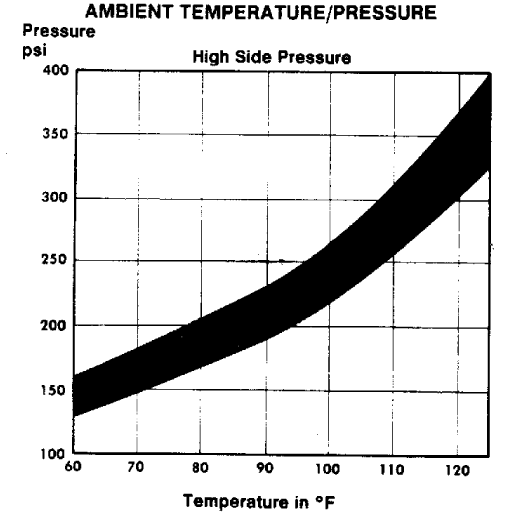
Fig. 4: Ambient Temperature/Pressure
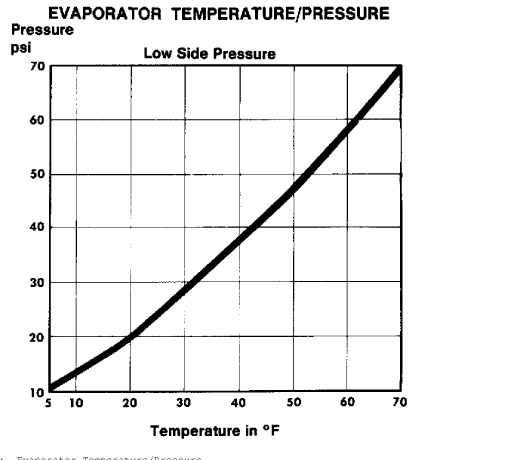
Fig. 5: Evaporator Temperature/Pressure
A/C SYSTEM DIAGNOSIS WITH GAUGES
DIAGNOSIS WITH GAUGES - SYSTEMS WITH INSUFFICIENT OR NO COOLING
LOW SIDE HIGH SIDE OTHER SYMPTOMS(1) DIAGNOSIS
GAUGE GAUGE
Normal Normal No or few bubbles in sight Some Air and
glass. High side gauge may Moisture in System
go high. Low side gauge
does not fluctuate with
compressor on/off cycle.
Normal Normal Cools okay in morning but Excessive Moisture
not during hot part of day. in System
Tiny bubbles in sight
glass. Discharge air warm
when low side gauge drops
into vacuum.
Normal Normal Thermostatic switch system Defective Thermoonly-
compressor cycles off static Switch
and on too rapidly.
Normal Normal Cycling clutch systems Misadjusted Thermo
to High only-Compressor doesn’t static Switch or
turn on soon enough. Defective Pressure
Discharge air becomes Sensing Switch
warm as low side
pressure rises.
Low Low Bubbles in sight glass. Low R-12 Charge
Outlet air slightly cool.
Low Low Sight glass clear or oil- Excessively Low
streaked. Outlet air very R-12 Charge
warm.
Low Low Outlet air slightly cool. Expansion Valve
Sweating or frost at Stuck Closed.
expansion valve. Screen Plugged or
Sensing Bulb
Malfunction
Low Low Outlet air slightly cool. Restriction on
High side line cool to High Side.
touch. Sweating or frost
on high side.
Low High Evaporator outlet pipe STV Stuck Open
cold. Low side goes into
vacuum when blower is
disconnected.
High Low Evaporator outlet pipe STV Stuck Open
warm. Outlet air warm.
High Low Noise from compressor Compressor
Malfunction
High High Outlet air warm. Condenser
Liquid line very hot. Malfunction or
Bubbles in sight glass. R-12 Overcharge
High High Outlet air slightly cool. Large Amount of
Bubbles in sight glass. Air and Moisture
in System.
High High Outlet air warm. Expansion Valve
Evaporator outlet Stuck Open.
sweating and frost.
(1) - If equipped with a low refrigerant charge protection system,
compressor operation may have stopped.
A/C SYSTEM SERVICE SPECIFICATIONS
REFRIGERANT OIL & R-12 CAPACITY TABLE
(1) Oil R-12
Application Ounces Ounces
Eagle ......................... 5.7 ........................... 36
(1) - Total system capacity, unless otherwise noted.
SYSTEM REFRIGERANT CAPACITIES
Application Pounds Ounces
Eagle
Medallion & Premier ..... 1 7/8 .............. 29
Summit (FX105V) ......... 2 1/4 .............. 36
Jeep
CJ Models ............... 2 1/2 .............. 40
Comanche .................. 2 ................ 32
All Other Jeep Models . 2 1/4 .............. 36
COMPONENT OIL REPLACEMENT QUANTITIES
Component Ounces
Accumulator ................................... (1)
Condenser ....................................... 1
Evaporator ...................................... 1
Receiver-Drier .................................. 1
Compressor
Premier ....................................... (1)
Medallion ..................................... 5.7
Grand Wagoneer .................................. 8
All Other Jeep Models ........................... 7
(1) - Add amount drained plus 1 ounce.
COMPRESSOR BELT TENSION (Lbs.) (1)
Application New Belt Used Belt
Eagle
1.4L & 1.7L ............ 120-160 ......... 90-115
Jeep
Regular Belt ........... 125-155 ......... 90-115
Serpentine Belt ........ 180-200 ........ 140-160
(1) - Using standard strand tension gauge.
COOLING SYSTEM CAPACITIES (1)
Application Quarts (Liters)
Eagle
Medallion & Premier
With A/C .............................. 4.8 (4.5)
Without A/C ........................... 4.4 (4.2)
Jeep
Cherokee & Wagoneer (2)
4-Cylinder ........................... 10.0 (9.5)
V6 .................................. 12.0 (11.4)
CJ & Scrambler
4-Cylinder ............................ 9.0 (8.5)
6-Cylinder ........................... 10.5 (9.9)
Grand Wagoneer & Truck (3)
6-Cylinder .......................... 12.5 (11.8)
V8 .................................. 15.5 (14.7)
(1) - May vary +/- 15% due to system variations.
(2) - Includes 2.3 qts. (2.2L) in recovery bottle.
(3) - Includes 1 qt. (.9L) for heater.